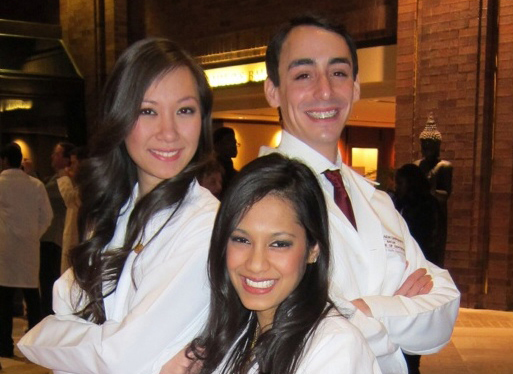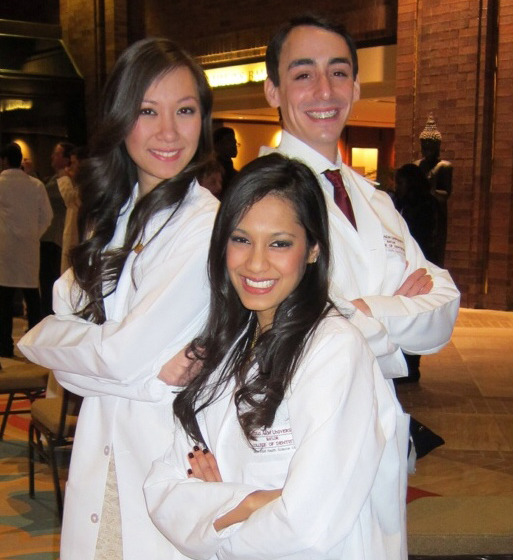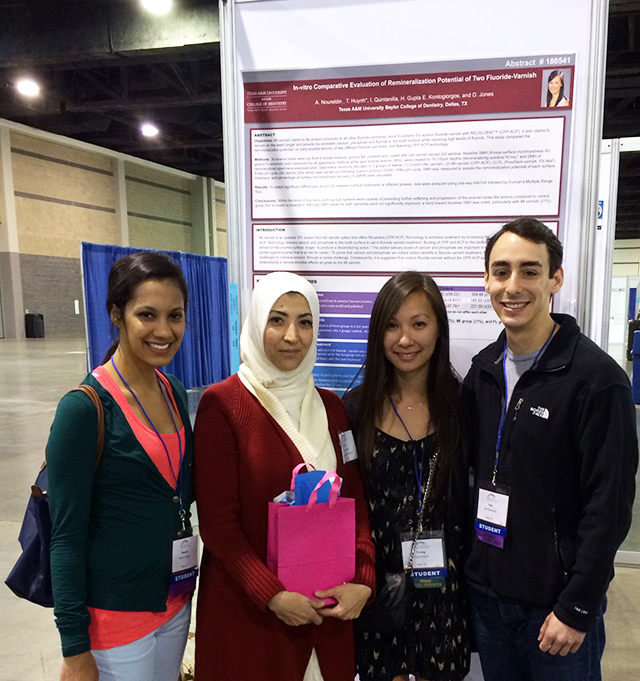3 is a lucky number

This trio of second-year dental students had no funding for their summer research projects and more than a few obstacles to overcome. Three abstracts and national poster presentations later, they share their findings before a familiar audience at TAMBCD.
A framed photo of Dr. Amal Noureldin’s three sons graces her desk. A second image is perched on the window ledge, also on prominent display. This one is a gift from her other “kids,” second-year dental students Heena Gupta, Ines Quintanilla and Trang Huynh, in poses mirroring her boys’ and sporting the same wide grins.

They’re known as the “three musketeers” and she as “mom,” even if just in jest.
The Predoctoral Student Research Program cemented Noureldin’s role as mentor to the students last summer, and the lengthy hours spent in the lab created a friendship among Gupta, Quintanilla and Huynh. The experience culminated March 19 to 22, when they attended the American Association for Dental Research annual meeting, where the three were invited to share their research findings along with 29 other students from Texas A&M University Baylor College of Dentistry. They also discussed their work on campus April 2 during the Research and Scholars Day poster presentations, with Quintanilla winning second place for his findings.
The group’s efforts trace back to spring 2013, when Noureldin, an assistant professor in public health sciences, announced that she had three slots open to students interested in the student research program. The topic, which had full support from Dr. Dan Jones, chair of public health sciences, hinged on whether the use of two applications of fluoride in tandem with carbon dioxide lasers is effective in the prevention and treatment of tooth decay. It would require no grant funding and was purely clinical in nature. Using lasers is common in the dental world for soft-tissue surgery, says Noureldin, but using it in a very low intensity in combination with fluoride varnish is a novel concept.
“I wanted to see the feasibility of using this for our community clinics and sealant programs,” says Noureldin. “If we could get the best results in caries prevention that would be great.”
The topic was separated into three projects. Gupta and Quintanilla were to explore the method’s effectiveness at prevention and treatment, respectively, and Huynh would compare two types of fluoride for their ability to remineralize enamel and slow the progression of cavities.
Preparation for the experiment was smooth. By June, the painstaking process of collecting extracted teeth was complete. The laser, on loan from Dr. Jeffrey Rossmann, chair of the periodontics department, had been calibrated and the students trained on how to use it. Then — as is often the case with research — the unexpected occurred.
First the laser malfunctioned.
“With this delay there was no way we were going to finish on time,” Quintanilla says. By the time the laser repairs were completed in late August, classes had already begun, and the students still had weeks’ worth of work, including several pH scale cycles, which required one of them to be at the school every day, sometimes at odd hours.
When the computer that housed the group’s first round of results crashed, causing them to lose all of their data, they were undeterred.
“It was definitely a team effort those last three weeks,” says Gupta, of the group’s willingness to alternate holidays and eventually nights and weekends well into the academic year.

Quintanilla attributes the group’s cohesion to the fact that they not only finished the project but achieved noteworthy results in the process.
“In a class of 100 there are personalities that clash at times,” says Quintanilla. “Luckily all three of us have a similar mindset.”
By late September, the team had their results. The double fluoride application-laser sequence was found to be effective in caries prevention by improving the enamel’s resistance to acid attacks. On the treatment front, the method not only halted progression of white spot lesions indicative of caries, it rehardened them, as well.
The relevance of the findings was not lost on Gupta, Huynh, Quintanilla or the hundreds of conference attendees who discussed the research with the students during their poster presentations at AADR.
“Being about cariology it was definitely relevant to practitioners out there,” says Quintanilla. “Everything worked out. We couldn’t have asked for a better experience or a better team.”
Check out the photo gallery featuring Gupta, Huynh and Quintanilla, as well as many of TAMBCD’s 2014 Research & Scholars Day participants.
—Jenny Fuentes